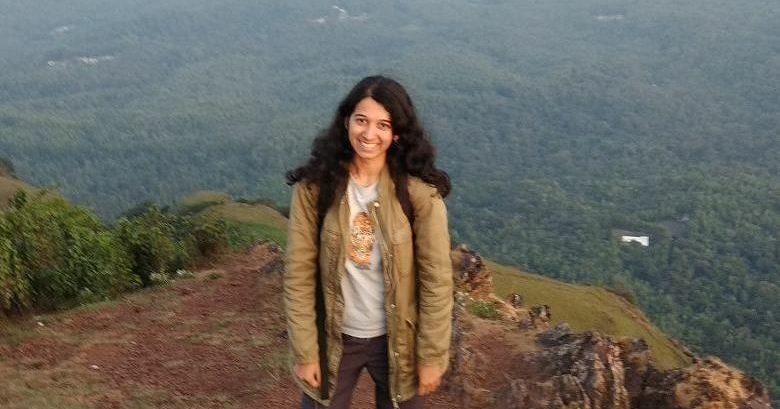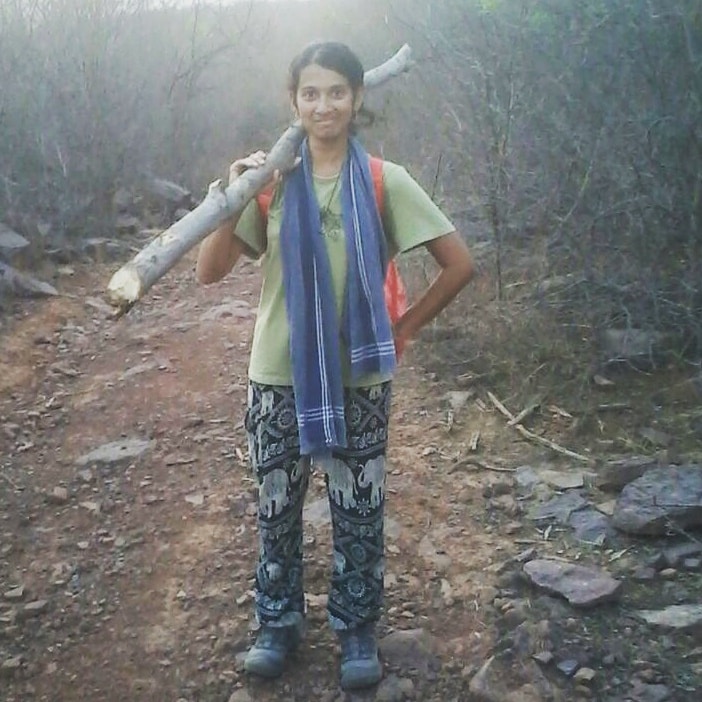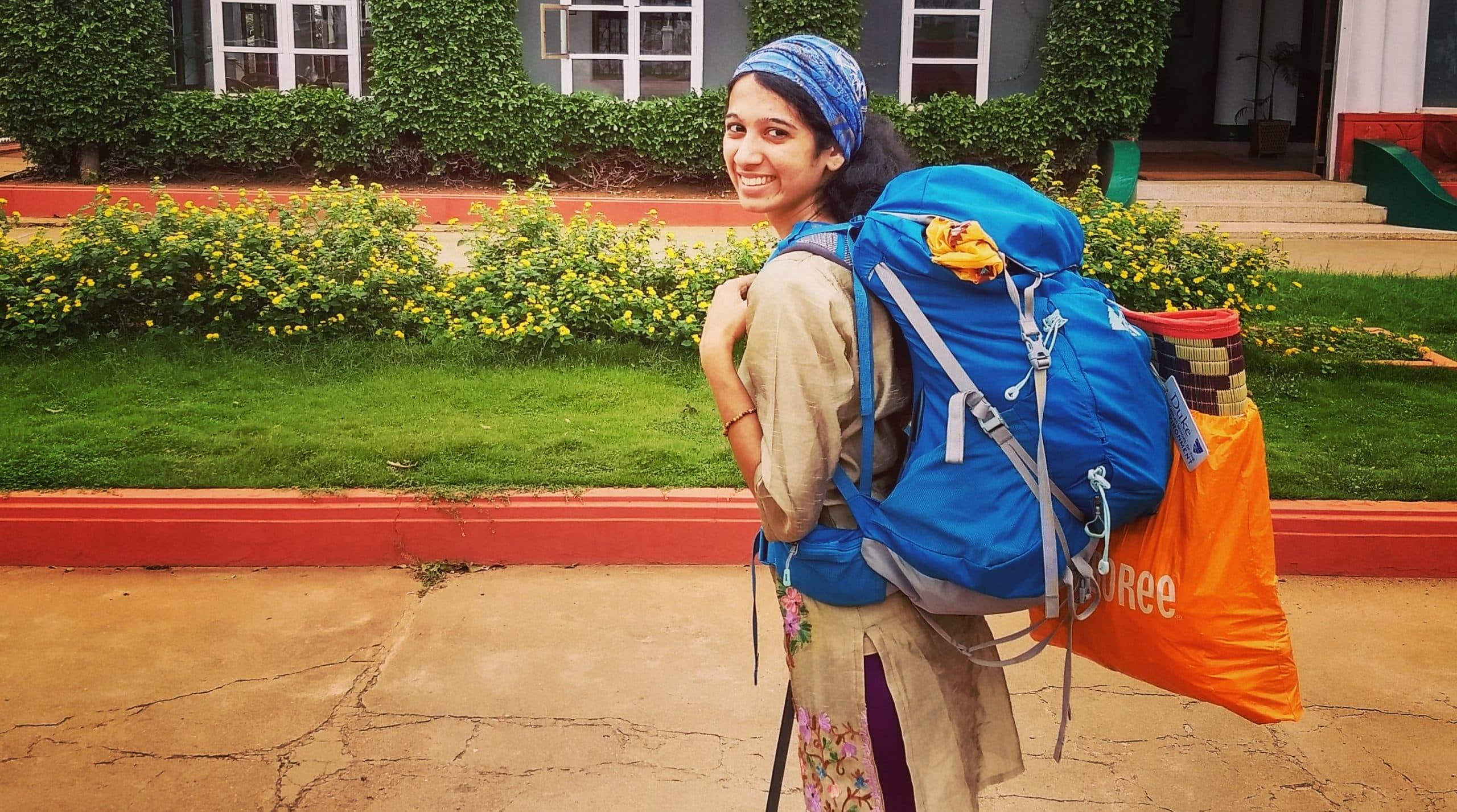Rapid motions on the walls and in the cracks of field stations no longer startle me.
For a girl who grew up in the big city, I have always known how to share a small space with those around me, be it family, neighbours, or local wildlife. In India, local wildlife includes the usual amalgamation of house lizards, rat snakes, rats, mice, pigeons, crows, sparrows, cockroaches, spiders and other creepy-crawlies, the occasional grumpy monkey, and countless squirrels. At an early age, I developed an interest in wildlife and nature, and naturally, I jumped at every opportunity to handle these household visitors.

The author stands overlooking the forests of Bhadra Tiger Reserve from one of the highest points in Karnataka (Image Credits: Priya Ranganathan)
What? Do you really mean to say you never did this?
I adore fieldwork and I am a field ecologist to the bone. True back-breaking, exhausting, rain-or-shine fieldwork fuels me and pushes me to learn more about our wild country and about myself along the way. Fieldwork is a journey of understanding your limits and setting new ones, of pushing yourself to constantly be stronger, faster, hardier, and more open-minded. In childhood, playing on the streets in the dust and rain, sitting on the wall of my compound and watching the local mongoose pick yet another fight with our resident snake, or feeding pigeons countless handfuls of yellow moong dal taught me to embrace the wilder side of our cossetted human lives.
My first tryst with fieldwork was in the hills of Mussoorie, where I was looking at Himalayan ecology and geology. Himalayan griffons circled on air thermals far above the rhododendron-strewn hills of the Garhwal Himalayas, and I cherished waking up to the call of the vain peacock who insisted on admiring himself in the glass on my window. I woke up each morning in a cloud of mist, my eyes unable to spot my toes through the dense condensation. The sawing call of a hunting leopard sent shivers of joy down my spine. In the Himalayas, I learnt that water is precious and fleeting, that the monsoon brings joy and landslides, that a thunderstorm means filled water tanks and power outages. I learnt to admire and fear the power of thundering rivers and tasted their clear cool waters in the safety of the hills.

A tigress prowls across the dirt road in Nagarahole Tiger Reserve (Image Credits: Himani Somnathan/Priya Ranganathan)
From the high mountains, I found myself on the edge of the arid Thar Desert, in Ranthambhore, a place cherished for its Tiger population. A smallish national park near Sawai Madhopur, Ranthambhore is equally famous for both its tigers and its poor tourism practices. As a student ecologist in her post-graduate internship period, I was collecting field data for my thesis on the quality and wildlife usage of the dispersal corridors between Ranthambhore and neighbouring wildlife sanctuaries that were safe-spots for India’s favourite striped kitty cat. As I tanned further and further and grew leaner and hardier, I learnt to identify the pugmarks of tigers, leopards, caracals, Indian wolves, jungle cats, jackals, red fox, desert cat, and leopard cats. I spent hours crouched by steaming piles of scat and pellets, noting down the species that had kindly littered the path and sometimes photographing the smelly find.
Some days, our transects were full of wildlife, and I recall a particularly memorable morning at 5 am when I startled a pair of mating nilgai (blue bull) into accidentally falling over into a thorny bush. I scaled the hill leading up to Khandar Fort, home of a legendary tigress and leopard, and came across a hyena for good measure! And I learnt that I could handle a lot more than I had ever thought myself capable of handling – be it jump-starting a cranky old Gypsy, driving said Gypsy through mud and sand, conversing in local Hindi slang with casual ease and only a few faux paus, and learning to quickly set up and dismantle camera traps. I also learnt how to track a tiger without appearing like easy prey and how to use all of my senses while in the forest to stay one step ahead of danger.
And I adored it.

Tiger surveys in Ranthambhore Tiger Reserve, accompanied by a stout stick for protection! (Image Credits: Sailaja Nayak)
A memorable night in the ravines of the Chambal solidified my fascination with one carnivore in particular – the Indian wolf. My field assistant and I were tracking sloth bear pugmarks in the ravines by the Chambal River, the haunt of bandits since the time of Phulan Devi, when the still air was split by a lonely, echoing howl. It was nearing dusk, the time that most predators are active, and my senses were on high alert. We were in a lower part of the ravines, and the cliffs towered above us, covered in golden sand and short stubby Prosopis trees. Suddenly, out of the sandy shadows melted the figures of two Indian wolves. Indian wolves are elusive and rarely sighted in the semi-arid landscape of Rajasthan. They glanced at us but paid us no attention, sensing that we were harmless. They frolicked for a while, playing what looked like a very animated game of catch-me-if-you-can, and one of the wolves pinned the other, tail wagging much like an excitable dog. I couldn’t help but smile at their carefree play, my work was forgotten.
But even wolves can be outnumbered, and all at once, the landscape was filled with the cacophony of jackals baying. The song of the jackal was a common accompaniment to my fieldwork, and I was not nervous, but the wolves glanced at each other and then vanished like ghosts. The only traces of their presence were in the light pawprints that they left behind on the soft sand and in my heart.

A golden jackal stands watch (Image Credits: Steve Garvie/Creative Commons)
The field and long hours in the wild have shaped me into the ecologist I am today, and I remain optimistic about the future for India’s wild spaces when I travel into their depths, seeking answers to questions that hopefully preserve the planet for future generations to admire.


